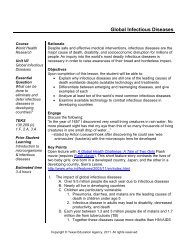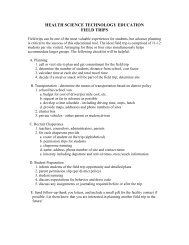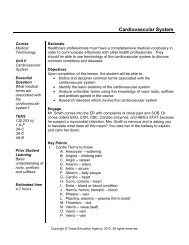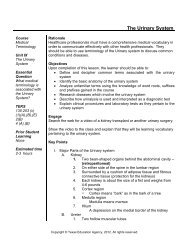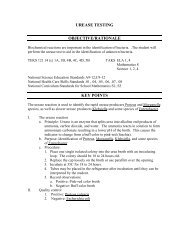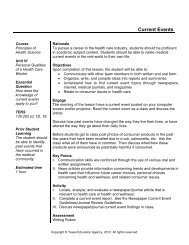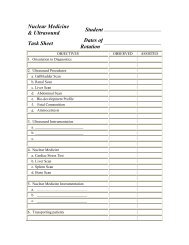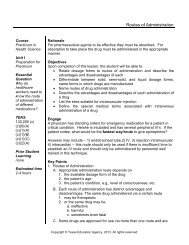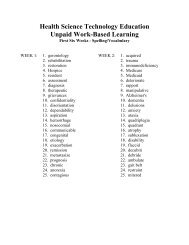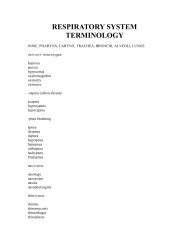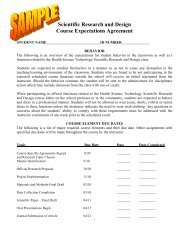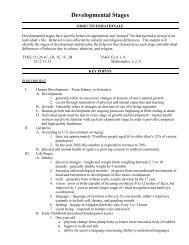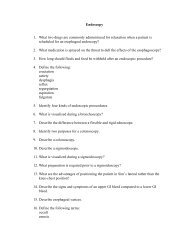Laboratory Basics - Health Science Technology Education
Laboratory Basics - Health Science Technology Education
Laboratory Basics - Health Science Technology Education
You also want an ePaper? Increase the reach of your titles
YUMPU automatically turns print PDFs into web optimized ePapers that Google loves.
<strong>Laboratory</strong> <strong>Basics</strong><br />
Course<br />
Pathophysiology<br />
Unit II<br />
<strong>Laboratory</strong><br />
<strong>Basics</strong> and the<br />
Tools of<br />
Investigation<br />
Essential<br />
Question<br />
What equipment<br />
aids the scientist<br />
in a laboratory?<br />
TEKS<br />
130.208 (c)<br />
1A, 1B<br />
Prior Student<br />
Learning<br />
n/a<br />
Estimated time<br />
2-5 hours<br />
Rationale<br />
In the laboratory, students learn by actively conducting and observing<br />
experiments to better understand the principles discussed in the textbook or<br />
in class.<br />
Objectives<br />
Upon completion of this lesson, the student will be able to:<br />
• Understand the metric system<br />
• Convert units of measurement<br />
• Develop a standard operating procedure<br />
• Learn the correct way to use a triple beam balance<br />
• Care for a compound microscope<br />
Engage<br />
What types of measurements might you need to make in the laboratory?<br />
Key Points<br />
I. Metric System – metric units consist of a prefix and a base word. The<br />
base word tells the kind of measurement being taken, and the prefix tells<br />
the size of the item being measured. The most commonly used prefixes<br />
are milli-, centi-, and kilo-. The metric system is based on the decimal<br />
system (multiples of 10). Because the metric system is based on powers<br />
of 10, it is easy to convert from one derived unit to another. For example,<br />
there are 100 centimeters in a meter and there are 10 decimeters in a<br />
meter. Therefore, there are 10 centimeters in 1 decimeter.<br />
A. Length measurements – the unit of length is the meter. A meter is<br />
equal to 39.4 inches in the English system, which we use in the<br />
United States. When the prefix kilo- is added to the base unit<br />
meter, the word kilometer is formed (a derived unit meaning 1000<br />
meters).When the prefix centi- is combined with the base unit<br />
meter, the word centimeter is formed (a derived unit meaning 1/100<br />
of a meter). The following chart lists some commonly used prefixes<br />
and their meanings. The prefixes modify the value of the base to<br />
describe very small lengths or very long distances.<br />
B. Mass measurements – the amount of matter in an object is known<br />
as its mass. The mass of an object is a measure of how difficult it is<br />
to change the object’s state of motion. The more mass an object<br />
has, the harder it is to start it moving, stop it from moving, or<br />
change its direction. The international standard unit of<br />
measurement for mass is the kilogram (kg). One liter of water has a<br />
mass of 1 kg. The device we use to determine mass is a balance.<br />
Three common types of balances are the equal-arm, triple-beam,<br />
and analytical balance.<br />
Copyright © Texas <strong>Education</strong> Agency, 2012. All rights reserved.
C. Volume measurements – as area is used to describe a twodimensional<br />
region, volume represents the measure of a threedimensional<br />
figure. Volume is how much space an object occupies.<br />
Volume can be shown with closely stacked cubes that fill a certain<br />
space, and have no gaps between them. Units of volume are<br />
based on cubes and are called cubic units. As shown in Figure 5,<br />
the volume of a rectangular solid can be measured by determining<br />
how many cubes cover the base and by counting how many layers<br />
of these cubes are needed to reach the height of the object.<br />
Prefix Symbol Exponential Rational Meaning<br />
tera T 1012 1,000,000,000,000 trillion<br />
giga G 109 1,000,000,000 billion<br />
mega M 106 1,000,000 million<br />
kilo k 103 1,000 thousand<br />
hecto h 102 100 hundred<br />
deka da 101 10 ten<br />
deci d 10–1 1/10 one tenth<br />
centi c 10–2 1/100 one hundredth<br />
milli m 10–3 1/1,000 one thousandth<br />
micro μ 10–6 1/1,000,000 one millionth<br />
nano n 10–9 1/1,000,000,000 one billionth<br />
pico p 10–12 1/1,000,000,000,000 one trillionth<br />
II. Triple Beam Balance – a triple-beam balance determines the mass of an<br />
object in grams.<br />
A. How to use a triple-beam balance<br />
1. Make sure the balance is on a level surface and that the pan<br />
can move freely. Position all the sliders to zero. Use the<br />
adjustment knob (usually located under and to the left of the<br />
pan) if the pointer does not come to rest in the middle of the<br />
scale.<br />
2. Place the mass on the pan.<br />
3. Move the largest rider along the beam to the right until it is at<br />
the last notch that does not move the pointer below the zero<br />
point in the center of the scale.<br />
4. Follow the same procedure with the next largest rider.<br />
5. Move the smallest rider until the pointer rests at zero in the<br />
middle of the scale.<br />
6. Total the readings on all the beams to determine the mass of<br />
the object.<br />
III. Microscope – compound microscopes contain a number of lenses,<br />
Copyright © Texas <strong>Education</strong> Agency, 2012. All rights reserved.
usually 10x in the eyepiece and 10x, 40x or 45x, and 100x (immersion<br />
oil) lenses in the objectives. The microscope magnification is calculated<br />
by multiplying the eyepiece magnification by the objective magnification.<br />
For example:<br />
10x (eyepiece) x 100x (objective) = 1000x<br />
The specimen is therefore magnified 1000 times<br />
A. Definitions<br />
1. Resolution – the microscope’s ability to distinguish between<br />
two points that are close together. The resolving power is<br />
expressed in length.<br />
2. Oil immersion objective – this objective uses immersion oil to<br />
allow light to pass through it the same way light passes<br />
through the glass slide. The oil decreases the bending of the<br />
light rays allowing more light to pass directly to the specimen.<br />
3. Binocular – a microscope with two eyepieces as opposed to<br />
one. Most hospital laboratories use binocular microscopes.<br />
B. Components of the Microscope<br />
1. Eyepiece<br />
2. Arm<br />
3. Base<br />
4. Binocular tube<br />
5. Revolving nosepiece<br />
6. Objective lens<br />
7. Mechanical stage<br />
8. Stage clips<br />
9. Iris diaphragm<br />
10. Coarse adjustment knob<br />
11. Fine adjustment knob<br />
12. Lamp<br />
13. Bulb<br />
14. On/off switch<br />
C. Using the Microscope<br />
1. Lower the stage to its lowest position using the coarse<br />
focusing knob. Always start with the 10x power objective.<br />
2. Place the slide on the stage and place the stage clips on top<br />
of the slide to hold the slide in place.<br />
3. Use the coarse adjustment knob to focus on the slide, and<br />
then use the fine adjustment knob until the object is in sharp<br />
focus.<br />
4. Adjust the light intensity by raising and lowering the<br />
condenser to give the best image.<br />
5. After focusing with the 10x objective, rotate the 40x objective<br />
into the position over the slide. Use only the fine adjustment<br />
knob to obtain a sharp image.<br />
6. Rotate the objectives so that there is not a lens directly over<br />
Copyright © Texas <strong>Education</strong> Agency, 2012. All rights reserved.
the slide. Place one drop of the immersion oil on the slide.<br />
Slowly rotate the 100x objective into position over the slide.<br />
7. Use only the fine adjustment knob to focus on the specimen<br />
slide. Adjustment of light intensity may be necessary.<br />
8. To change slides during the investigation, follow steps 1<br />
through 7.<br />
9. At the conclusion of the laboratory investigation, lower the<br />
stage to the lowest position. Clean all lenses and place the<br />
10x objective in position.<br />
10. Wrap the cord around the arm of the microscope and replace<br />
the dust cover.<br />
D. Care of the Microscope<br />
1. The microscope should always be carried by the base and the<br />
arm.<br />
2. The microscope cord should be wrapped around the arm of<br />
the microscope.<br />
3. The microscope should always be covered with a dust cover<br />
to prevent dust buildup on the lenses.<br />
IV. Standard Operating Procedures (SOPs)<br />
A. What is an SOP?<br />
1. Documents used by laboratories to instruct personnel in how<br />
to perform particular tasks.<br />
2. Provide a step-by-step outline of how a task is to be<br />
performed.<br />
3. Indicate in which situations the task is done, who is qualified<br />
or responsible for the work, what problems may arise and how<br />
to deal with them, and how to document that the task was<br />
performed properly.<br />
4. Since everyone in a laboratory or company follows the same<br />
SOPs when performing tasks, SOPs help ensure that work is<br />
performed correctly and consistently over time, regardless of<br />
who is doing it.<br />
B. What to think about when writing an SOP.<br />
1. What is the purpose of the procedure? What will be the<br />
outcome or product of the procedure?<br />
2. What resources and materials will the person performing the<br />
SOP require in order to achieve the desired result? What<br />
equipment will they need? Does the model of equipment need<br />
to be specified? What supplies and reagents are needed? Is a<br />
raw material produced by a particular manufacturer needed?<br />
3. What steps will the person following the SOP perform to<br />
achieve the desired product? What must the person do to<br />
ensure that the product of the SOP is good? Are there any<br />
potential problems that the person may run into while<br />
performing the SOP? If so, how can these problems be<br />
Copyright © Texas <strong>Education</strong> Agency, 2012. All rights reserved.
avoided?<br />
4. It is important that the SOP be complete and clearly written so<br />
that others can follow it.<br />
Activity<br />
I. Complete the Converting Measurements Activity.<br />
II. Complete the SOP Activity.<br />
III. Complete the Using a Balance Activity.<br />
IV. Complete the Triple-Beam Balance <strong>Laboratory</strong> Investigation.<br />
V. Complete the Microscope <strong>Laboratory</strong> Investigation.<br />
Assessment<br />
<strong>Laboratory</strong> Investigation Rubric<br />
Materials<br />
http://www.scienceteacherprogram.org/biology/biolps.html<br />
Converting Measurements Key<br />
Math Conversion Chart<br />
Accommodations for Learning Differences<br />
For reinforcement, the student will practice basic mathematical conversion<br />
problems.<br />
For enrichment, the student will investigate the use and application of the<br />
electron microscope and design a multimedia presentation.<br />
National and State <strong>Education</strong> Standards<br />
National <strong>Health</strong> <strong>Science</strong> Cluster Standards<br />
HLC01.01 Academic Foundations<br />
<strong>Health</strong> care workers will know the academic subject matter required (in<br />
addition to state high school graduation requirements) for proficiency within<br />
their area. They will use this knowledge as needed in their role.<br />
HLC06.01<br />
<strong>Health</strong> care workers will understand the existing and potential hazards to<br />
clients, co-workers, and self. They will prevent injury or illness through safe<br />
work practices and follow health and safety policies and procedures.<br />
HLC06.02<br />
<strong>Health</strong> care workers will understand the fundamentals of wellness and the<br />
prevention of disease processes. They will practice preventive health<br />
behaviors among their clients.<br />
HLC1O.01 Technical Skills<br />
<strong>Health</strong> Care Workers will apply technical skills required for all career<br />
specialties. They will demonstrate skills and knowledge as appropriate.<br />
Copyright © Texas <strong>Education</strong> Agency, 2012. All rights reserved.
TEKS<br />
130.208 (c) (1)(A) demonstrate safe practices during laboratory and field<br />
investigations; and<br />
130.208 (c) (1)(B) demonstrate an understanding of the use and<br />
conservation of resources and the proper disposal or recycling of materials.<br />
Texas College and Career Readiness Standards<br />
English Language Arts<br />
II. B. Understand new vocabulary and concepts and use them accurately in<br />
reading writing and speaking.<br />
III. B. Develop effective speaking styles for both group and one on one<br />
situations.<br />
IV. A. Apply listening skills as an individual and as a member of a group in a<br />
variety of settings.<br />
Mathematics<br />
I. B. 1. Perform computations with real and complex numbers.<br />
IV. A. 1. Select and use the appropriate type of unit for the attribute being<br />
measured.<br />
IV. B. 1. Convert from 1 measuring system to another<br />
<strong>Science</strong><br />
1.E.1. Use several modes of expression to describe or characterize natural<br />
patterns and phenomena. These modes of expression include narrative,<br />
numerical, graphical, pictorial, symbolic, and kinesthetic.<br />
1.E.2. Use essential vocabulary of the discipline being studied.<br />
2. A. 1. Understand the real number system and its properties.<br />
2. A. 7. Use calculators, spreadsheets, computers, etc., in data analysis.<br />
3.A.1. Use correct applications of writing practices in scientific<br />
communication.<br />
Copyright © Texas <strong>Education</strong> Agency, 2012. All rights reserved.
MATH CONVERSION CHART<br />
Length<br />
1 meter = 100 centimeters<br />
1 meter = 1000 millimeters<br />
10 millimeters = 1 centimeter<br />
Volume for Fluids<br />
1 liter = 1000 milliliters<br />
1 milliliter = 1 cubic centimeter<br />
10 centiliters = 1 deciliter<br />
10 deciliters = 1 liter<br />
Weight Conversions<br />
1 gram = 1000 milligrams<br />
1 kilogram = 1000 grams<br />
1 kilogram = 2.2 pounds<br />
1 pound = 16 ounces<br />
Terms and abbreviations<br />
Gram (g) measures mass or weight<br />
Liter (l) measures volume or liquid<br />
Meter (m) measures length or distance<br />
Kilo (k) = thousands<br />
Deci (d) = tenths<br />
Centi (c) = hundredths<br />
Milli (m) = thousandths<br />
Copyright © Texas <strong>Education</strong> Agency, 2012. All rights reserved.
Converting Measurements: Volume<br />
Solve the following problems. Show your work.<br />
1. Jeremy is asked to prepare 2 liters of a 2% solution of sodium chloride. Can he use a 2-quart<br />
container to store the solution?<br />
2. Mrs. Jonas drinks 4 ounces of orange juice and 8 ounces of milk. What is her fluid intake in<br />
milliliters?<br />
3. Sam needs to dilute 1 quart of stock disinfectant to 1 gallon for cleaning rubber tubing. How<br />
many liters of diluted disinfectant will he have?<br />
4. In measuring output for Mr. Emery, Jill collects 250 milliliters of urine and 45 millimeters of<br />
vomitus. How many total ounces is this?<br />
5. Evelyn Smith requires 2 pints of 5% glucose in saline. How many millimeters does she<br />
need?<br />
6. John and Mary decide to share a 12-ounce milk shake. If they divide it evenly, how many<br />
millimeters will they each have?<br />
Copyright © Texas <strong>Education</strong> Agency, 2012. All rights reserved.
Key - Converting Measurements: Volume<br />
1. No, 2 l = 2.11 qt.<br />
2. 360 ml<br />
3. 3.8 l<br />
4. 9.83 oz.<br />
5. 960 ml<br />
6. 180 ml<br />
Copyright © Texas <strong>Education</strong> Agency, 2012. All rights reserved.
Converting Measurements: Weight<br />
Solve the following problems. Show your work.<br />
1. Mr. Overton is very pleased to find he weighs only 100 kilograms. How many pounds does<br />
he weigh?<br />
2. Irene is allowed 15 grams of cheese each day. How many ounces will she need for a week?<br />
3. Karen needs 4 ounces of dry powder for a prescription for Sammy Bowman, but she only<br />
has scales to measure grams. How many grams does she need?<br />
4. A dye for kidney function tests is to be used at the rate of 0.1 gram per pound of body<br />
weight. If a patient weighs 80 kilograms, how many grams of dye would be needed?<br />
Copyright © Texas <strong>Education</strong> Agency, 2012. All rights reserved.
Key - Converting Measurements: Weight<br />
1. 220 lb.<br />
2. 3.7 oz.<br />
3. 112 g<br />
4. 17.6 g<br />
Copyright © Texas <strong>Education</strong> Agency, 2012. All rights reserved.
1. What is the purpose of an SOP?<br />
Standard Operating Procedure<br />
2. Suppose you were writing an SOP to operate an iPod.<br />
a. What is the purpose of the procedure?<br />
b. What will be the outcome or product of the procedure?<br />
c. What resources and materials will the person performing the SOP require in order<br />
to achieve the desired result?<br />
d. What equipment is needed?<br />
e. Does the model of equipment need to be specified?<br />
f. What supplies and reagents are needed?<br />
g. Is a raw material produced by a particular manufacturer needed?<br />
h. What are the steps in operating an iPod?<br />
Copyright © Texas <strong>Education</strong> Agency, 2012. All rights reserved.
Using a Balance<br />
With your assigned balance, complete the following:<br />
1. Who is the manufacturer and what is the model number? (This is important to know in<br />
case you have to call the company if it breaks or you need to order a replacement part.)<br />
2. Find the manual for the balance if available, or use the numbers on the balance to<br />
determine the following characteristics:<br />
a. maximum capacity: (largest mass it can hold) be sure and put the units (ie: grams,<br />
kilograms)<br />
b. range of masses it can hold (0 to _________)<br />
c. sensitivity – what is the smallest mass difference the balance can distinguish?<br />
3. Standard operating procedures (SOPs) are a scientist’s user’s guide. These are very<br />
important when first using a new piece of equipment. Using either the manual or personal<br />
experience (after you’ve used the balance several times), write an SOP for the use of this<br />
balance. Things to include in your SOP:<br />
a) directions for using the balance<br />
b) directions for cleaning the balance<br />
c) directions for storing/housing the balance<br />
4. Give your SOP to a fellow student and have him or her use the balance by reading the<br />
directions in your SOP. Revise your SOP if necessary.<br />
Copyright © Texas <strong>Education</strong> Agency, 2012. All rights reserved.
Triple-Beam Balance <strong>Laboratory</strong> Investigation<br />
Purpose<br />
In this laboratory investigation, the student will learn the correct way to use a Triple-Beam<br />
Balance, learn the parts of a Triple-Beam Balance, and take precise measurements when<br />
finding the mass of an object.<br />
Background Information<br />
Materials<br />
Sets of Brass weights: 200, 100, 50, 20, 10, 5, 2, & 1 gram<br />
Nickel<br />
Paperclip<br />
Empty 250 ml beaker<br />
Water<br />
Oil<br />
House key<br />
Triple-Beam Balances for student teams<br />
Procedure<br />
1. Listen and watch carefully to the demonstration on how to use the Triple-Beam Balance.<br />
2. You and your partner will share a triple-beam balance.<br />
3. Check to see that the pointer is pointing to zero.<br />
4. If it is not, check to see that all the riders are all the way to the left at the zero mark.<br />
5. Adjust the balance by turning the adjustment screw slowly until it points to zero.<br />
6. Place the known brass weights onto the pan and practice measuring until you are<br />
comfortable using the balance beam. Start with the largest mass, 200 g, and work your<br />
way down to the smallest mass, 1 g.<br />
7. Find the mass of the objects.<br />
8. Record their mass in Table 1.<br />
Copyright © Texas <strong>Education</strong> Agency, 2012. All rights reserved.
Data<br />
Table 1: Mass of the objects in grams.<br />
a nickel<br />
Empty 250<br />
mL beaker<br />
250 mL<br />
beaker filled<br />
100mL of<br />
water<br />
250 mL<br />
beaker filled<br />
with 100 mL<br />
of oil<br />
house key<br />
Grams<br />
Conclusion<br />
1. How should you hold a triple-beam balance?<br />
2. Why should your balance say zero before you place an object in the pan?<br />
3. What object had the largest mass?<br />
4. Was it easier to find the mass of an object with a lot of mass or a little amount of mass?<br />
Explain.<br />
Copyright © Texas <strong>Education</strong> Agency, 2012. All rights reserved.
Microscope <strong>Laboratory</strong> Investigation<br />
Purpose<br />
In this laboratory investigation, the student will care for a compound microscope and use all of<br />
the objectives.<br />
Background Information<br />
Materials<br />
Compound light microscope<br />
Lens paper<br />
Immersion oil<br />
3 prepared slides of different types of organisms (bacteria, molds, fungus, parasites, etc.)<br />
Procedure<br />
Examine the three slides and record your observations.<br />
Copyright © Texas <strong>Education</strong> Agency, 2012. All rights reserved.
Data<br />
SLIDE 1<br />
Type of Specimen:<br />
Magnification: 10x<br />
Type of Specimen:<br />
Magnification: 40x or 45x<br />
Type of Specimen:<br />
Magnification: 100x<br />
Copyright © Texas <strong>Education</strong> Agency, 2012. All rights reserved.
SLIDE 2<br />
Type of Specimen:<br />
Magnification: 10x<br />
Type of Specimen:<br />
Magnification: 40x or 45x<br />
Type of Specimen:<br />
Magnification: 100x<br />
Copyright © Texas <strong>Education</strong> Agency, 2012. All rights reserved.
SLIDE 3<br />
Type of Specimen:<br />
Magnification: 10x<br />
Type of Specimen:<br />
Magnification: 40x or 45x<br />
Type of Specimen:<br />
Magnification: 100x<br />
Copyright © Texas <strong>Education</strong> Agency, 2012. All rights reserved.
Conclusion<br />
1. Calculate the magnification of an object when the eyepiece is 10x and the high-dry objective<br />
lens is 45x.<br />
2. What is the purpose of immersion oil?<br />
3. Define resolution.<br />
4. What is the function of the iris diaphragm?<br />
5. What is the function of the revolving nosepiece?<br />
6. Predict the consequences of the following:<br />
a. lenses not cleaned before storage<br />
b. stage not lowered before cleaning lens<br />
c. using the coarse adjustment to focus the 100x objective<br />
Bonus<br />
What organisms cannot be viewed by using the compound microscope?<br />
Copyright © Texas <strong>Education</strong> Agency, 2012. All rights reserved.
<strong>Laboratory</strong> Investigation Rubric<br />
Student:____________________________<br />
Course:____________________________<br />
Date:______________________________<br />
Scoring Criteria 4.<br />
3.<br />
2.<br />
1.<br />
N/A<br />
Problem is<br />
appropriately<br />
identified<br />
Problem is<br />
precise, clear,<br />
and relevant<br />
Association<br />
between the<br />
problem and the<br />
predicted results<br />
is direct and<br />
relevant<br />
All variables are<br />
clearly<br />
operationalized<br />
Student<br />
demonstrates<br />
comprehension of<br />
the use of<br />
scientific<br />
concepts and<br />
vocabulary<br />
Excellent<br />
Good<br />
Needs Some<br />
Improvement<br />
Needs Much<br />
Improvement<br />
All significant<br />
data is measured.<br />
Data is recorded<br />
effectively and<br />
efficiently<br />
Data table is welldesigned<br />
to the<br />
requirements of<br />
the task.<br />
Copyright © Texas <strong>Education</strong> Agency, 2012. All rights reserved.
All graph forms<br />
are appropriate.<br />
All data is<br />
accurately plotted<br />
Graph is visually<br />
compelling,<br />
highlights<br />
conclusions of the<br />
study<br />
Conclusion<br />
relates directly to<br />
the hypothesis<br />
Conclusion has<br />
relevancy in the<br />
resolution of the<br />
original problem<br />
Conclusion<br />
relates the study<br />
to general interest<br />
Copyright © Texas <strong>Education</strong> Agency, 2012. All rights reserved.



